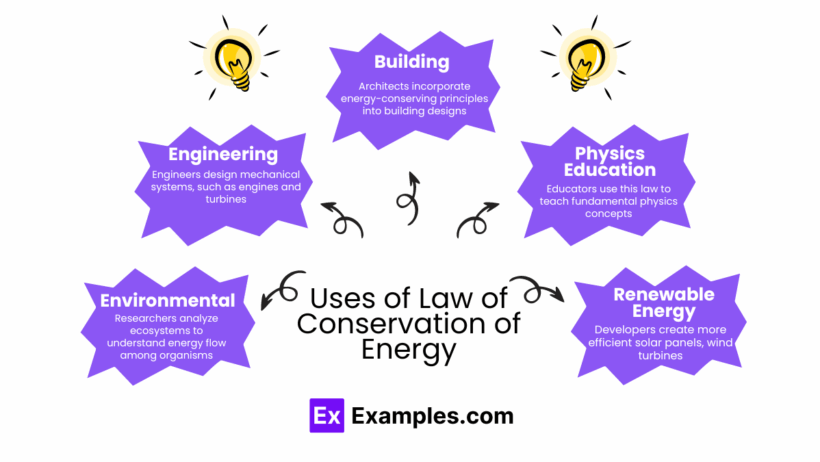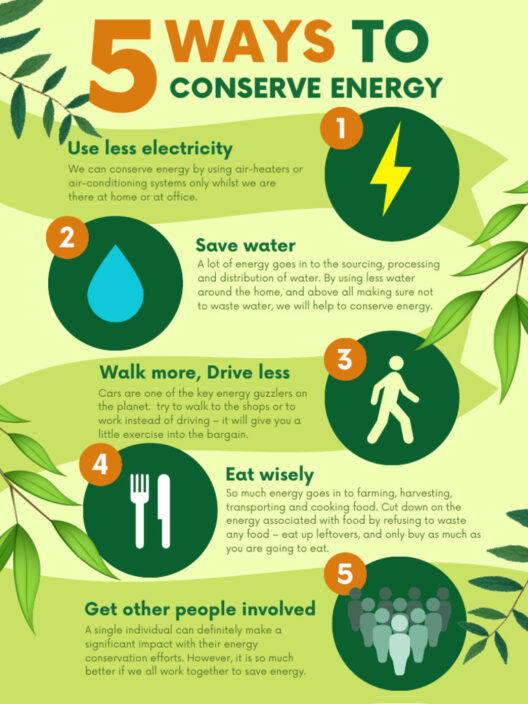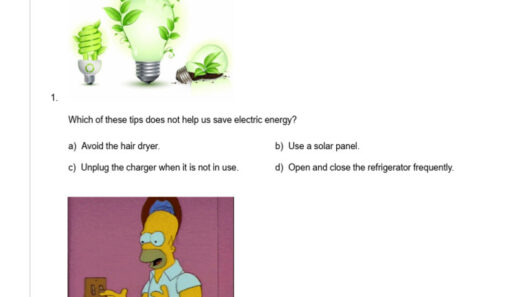The Law of Conservation of Energy is an immutable principle of physics that stipulates that energy cannot be created or destroyed; it can only be transformed from one form to another. This tenet is foundational not just in the realm of science, but also manifests itself in diverse, practical applications in our everyday lives. A plethora of examples illustrate this phenomenon, showcasing the transformative power of energy and its innate presence in various systems.
One quintessential example of the Law of Conservation of Energy in action is the process of photosynthesis. In this remarkable biochemical phenomenon, plants convert solar energy into chemical energy stored as glucose. Sunlight serves as the initial energy input, while carbon dioxide and water are the reactants. Through a series of complex reactions facilitated by chlorophyll, the green pigment in plants, solar energy is transformed into a storable form. This transformation is not merely an academic concept but underscores the very basis of life on Earth. By capturing the sun’s energy, plants create biomass, which sustains herbivores and, consequently, carnivores within the ecosystem.
Another compelling illustration is found in the operation of hydroelectric power plants. These facilities harness the gravitational potential energy of water stored in elevated reservoirs. When released, the water flows through turbines, which convert this gravitational energy into mechanical energy. Subsequently, through the synergistic operations of generators, mechanical energy is transformed into electrical energy. This process highlights not only the transformation of energy but also speaks to a larger conversation about renewable resources and sustainable practices. The environmental ramifications of harnessing hydroelectric power, compared to fossil fuel alternatives, elucidate the necessity of energy conservation in contemporary society.
In the domain of mechanical systems, the motion of a pendulum epitomizes the conservation of energy. When a pendulum swings, kinetic energy at its lowest point transforms into potential energy at the highest points of its arc. This continuous exchange exemplifies how energy shifts between forms without diminishing in total quantity. This cyclical movement serves as an elegant reminder of the perpetual nature of energy, encapsulating both the simplicity and complexity intrinsic to physical laws.
Combustion engines provide another illustrative example of energy conservation. In such engines, chemical energy from fuel undergoes combustion, producing thermal energy. The expansion of gases drives pistons, converting thermal energy into mechanical work. This transformation underscores the intricacies of energy conversion and highlights ongoing innovations aimed at improving efficiency. The importance of optimizing these processes cannot be understated, especially in the context of mitigating climate change and reducing our carbon footprint.
Everyday appliances also offer relatable instances of the Law of Conservation of Energy. Consider a standard refrigerator, which operates by transferring thermal energy away from its interior to maintain a low-temperature environment. Through the process of refrigeration, electrical energy is utilized to initiate this transfer. As the heat is expelled from the appliance, thermal energy is expelled from one area, while the internal environment remains at a steady and low temperature. This transformation underscores thermodynamics, as energy continually shifts forms as a result of mechanical processes driving the appliance’s function.
In the microcosm of our homes, even something as simple as cooking serves as an embodiment of energy transformation. When heat is applied to food, thermal energy is transferred, altering its chemical structure and physical properties. Through the application of heat, chemical reactions occur, resulting in a considerably different substance compared to its original state. The evolution of a food item—say, the conversion of raw eggs into cooked ones—demonstrates the practical implications of energy conservation and transformation in everyday applications.
Moreover, gravitational potential energy is evidenced in the operation of roller coasters. As the coaster ascends, it accumulates potential energy. Upon descent, the potential energy is converted into kinetic energy, propelling the coaster forward at increasing speeds. This thrilling experience starkly illustrates how energy conversions can lead to exhilarating outcomes, encapsulating the excitement and wonder we associate with physics in action.
Even in the vastness of space, the Law of Conservation of Energy is exemplified through stellar phenomena. Stars, including our own sun, undergo nuclear fusion, a process whereby hydrogen atoms combine under immense pressure and temperature to form helium, releasing astronomical amounts of energy in the form of light and heat. This captivating process not only powers the stars but also sustains life on Earth. The energy produced is a continuous loop of transformation, showcasing the vastness and endurance of energy within the universe.
Lastly, as we delve into the digital realm, energy conservation is apparent even in technology. In computer systems, electrical energy powers the hardware, enabling the software to function. When work is done, energy is transformed into heat, which must be dissipated to avoid overheating. Modern innovations focus on improving energy efficiency, underscoring the importance of reducing energy waste in an increasingly digital world.
In conclusion, the Law of Conservation of Energy is a profound concept that resonates through numerous examples across various fields. From biological systems to technological marvels, energy’s transformations play a pivotal role in the functionalities of countless processes. Understanding these examples encourages a greater appreciation for energy’s conservation and its implications for a sustainable future. It calls for a collective responsibility to preserve energy by embracing practices that foster efficiency and minimize waste, paving the way for a more sustainable existence on our planet.







